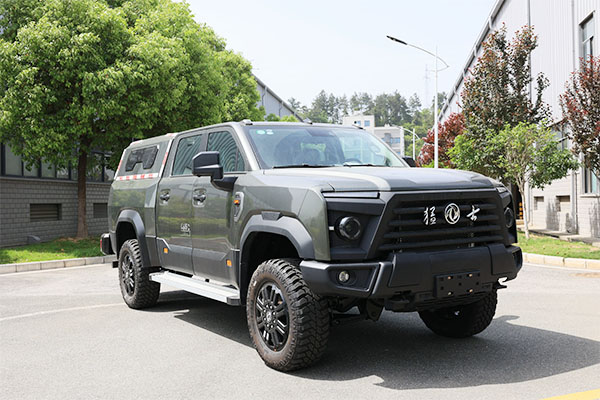How does a turbocharged engine in a high-performance all-terrain off-road vehicle cope with power loss during high-altitude off-road driving?
Release Time : 2025-09-01
At high altitudes, the air is thin and oxygen levels are significantly reduced. This leads to insufficient intake air for turbocharged engines, reduced combustion efficiency, and ultimately power degradation. Turbocharged engines in high-performance all-terrain off-road vehicles require multi-dimensional hardware optimization and system coordination to address these environmental deficiencies in key areas such as intake, combustion, and exhaust, ensuring stable power output during off-road driving. This approach isn't simply about increasing boost pressure, but rather building an adaptive system centered around "efficiently utilizing thin air," enabling the engine to maintain near-flatland combustion quality and power response even in low-oxygen environments.
Turbocharger hardware upgrades are fundamental to combating power degradation at high altitudes. These high-performance all-terrain off-road vehicles often utilize a variable geometry turbine (VGT) design. By adjusting the angle of the turbine blades, they precisely control boost pressure at varying speeds. At high altitudes and low speeds, the blade angle narrows, reducing intake resistance and allowing the turbine to reach operating speed more quickly, thus avoiding turbo lag caused by thin air. At high speeds, the blade angle widens, improving boost efficiency and forcing more lean air into the cylinders to compensate for oxygen depletion. Furthermore, the turbocharger bearings are often constructed with high-temperature-resistant, low-friction ball bearings to reduce mechanical resistance at high altitudes and low temperatures. This ensures stable operation in off-road conditions characterized by frequent starts and stops and speed fluctuations, preventing bearing jamming from further reducing boost efficiency.
Optimizations to the intake system focus on improving air density and cleanliness. The engine's intake duct features a short, large-diameter design to minimize pressure loss during airflow, allowing the thin air to enter the turbine more quickly. Select models also feature a high-flow air filter at the intake port, filtering out dust and dirt during off-roading while maintaining airflow and preventing a secondary reduction in intake volume due to filter clogging. Furthermore, the intake intercooler's area and heat dissipation efficiency have been specifically enhanced. While air temperature is lower at high altitudes, it still expands due to heat during the supercharging process. The intercooler's larger heat dissipation area and efficient cooling fan cool the compressed hot air, increasing its density and indirectly boosting the oxygen content in the cylinder, fostering optimal combustion.
Precise control of the fuel injection system is key to improving combustion efficiency. The engine is equipped with a high-pressure common rail fuel injection system, capable of injection pressures reaching several thousand bar. This atomizes the fuel into finer droplets, allowing for more thorough mixing with the thin air and preventing incomplete combustion due to oxygen depletion. At the same time, the engine management system (ECU) adjusts the injection strategy in real time based on the high-altitude environment. When sensors detect a decrease in intake air volume, the ECU simultaneously reduces fuel injection to maintain a reasonable air-fuel ratio (typically close to the stoichiometric air-fuel ratio of 14.7:1). This prevents both excessive fuel injection, which can lead to carbon deposits and power waste, and insufficient fuel injection, which can lead to insufficient power, ensuring that every ounce of fuel is used for maximum energy within the limited oxygen available.
Adapting the engine's compression ratio and ignition system is also essential. To adapt to the thin air at high altitudes, these engines use a lower compression ratio (typically between 9:1 and 10:1), reducing compression pressure within the cylinder and preventing the resulting low compression end temperature, which can affect ignition efficiency. Furthermore, the ignition system utilizes high-energy ignition coils and iridium spark plugs to enhance ignition energy and stability, ensuring successful ignition even with low in-cylinder mixture concentrations and minimizing misfires. Select models are also equipped with a variable valve timing system. This system adjusts the opening timing of the intake and exhaust valves to extend the intake time, allowing more lean air to enter the cylinders and further compensating for insufficient intake volume.
The exhaust system's low backpressure design assists the turbine's operation. The equal-length exhaust manifolds ensure uniform exhaust gas flow from each cylinder into the turbine, preventing turbine speed fluctuations caused by uneven exhaust gas flow. The appropriately increased exhaust pipe diameter and reduced muffler resistance lower exhaust backpressure, allowing the turbine to discharge exhaust more smoothly, improving turbine response and boost efficiency. At high altitudes, excessive exhaust backpressure can directly hinder turbine rotation. Low backpressure allows the turbine to reach operating speed more quickly, providing boost air to the engine in a timely manner and mitigating power loss.
Finally, the dynamic coordination and adaptability of the entire system ensure practicality in off-road applications. The engine ECU features a built-in high-altitude operating map. Using altitude and intake pressure sensors, it monitors environmental changes in real time, dynamically adjusting parameters such as boost pressure, injection advance, and ignition advance. For example, when climbing a steep slope, the ECU proactively increases boost pressure and intake air volume, ensuring sufficient climbing power in conjunction with the transmission's low-speed, high-torque gear. When frequently struggling on muddy roads, the ECU optimizes ignition timing to prevent engine stalls or power interruptions due to load fluctuations. This synergistic combination of hardware adaptation and software control ensures the turbocharged engine in high-performance all-terrain off-road vehicles can withstand environmental power degradation while adapting to complex road conditions, ensuring stable off-road performance.







